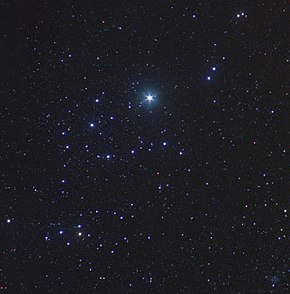| Alpha Persei Cluster | |
|---|---|
 | |
| Observation data (2000.0 epoch) | |
| Right ascension | 03h 26m 42.0s[1] |
| Declination | +48° 48′ 00″[1] |
| Distance | 570 ly[1] (175 pc[1]) |
| Apparent magnitude (V) | 1.2 |
| Apparent dimensions (V) | 6.1°[1] |
| Physical characteristics | |
| Estimated age | 50–70 Mya[2][3] |
| Other designations | Per OB3,[4] Cr 39, Mel 20, OCl 392.0[5] |
| Associations | |
| Constellation | Perseus |
The Alpha Persei Cluster, also known as Melotte 20 or Collinder 39, is an open cluster of stars in the northern constellation of Perseus. To the naked eye, the cluster consists of several blue-hued spectral type B stars. The most luminous member is the ~2nd magnitude yellow supergiant Mirfak, also known as Alpha Persei. Bright members also include Delta, Sigma, Psi, 29, 30, 34, and 48 Persei. The Hipparcos satellite and infrared color-magnitude diagram fitting have been used to establish a distance to the cluster of ~560 light-years (172 pc).[6][7] The distance established via the independent analyses agree, thereby making the cluster an important rung on the cosmic distance ladder. As seen from the Earth, the extinction of the cluster due to interstellar dust is around 0.30.[8]
The cluster is centered to the northeast of Alpha Persei.[8] It has a core radius of 11.4 ± 1.4 ly, a half-mass radius of 18 ly,[8] and a tidal radius of 70.6 ± 8.5 ly,[1] with 517 members being identified within the latter.[8] The cluster shows solid evidence of having undergone mass segregation, with the mean stellar mass decreasing toward the edge.[9] The age of this cluster is about 50–70 million years.[2][3] Cluster member stars show a near-solar metallicity, meaning the abundance of elements with atomic numbers higher than 2 are similar to those in the Sun.[8] The cluster shows evidence of tidal tails, which are most likely of galactic origin.[10]
The cluster field displays evidence of a much larger, background star stream. This feature is quite a bit older than the cluster, with an estimated age of 5 ± 1 Gyr. The center of the stream lies 290 ly from the cluster and it has an overall thickness of 590 ly along the line of sight. This is most likely the remains of an old, massive cluster that now has a combined mass of ~6000 M☉.[10]
- ^ a b c d e f Cite error: The named reference
Kharchenko2013was invoked but never defined (see the help page). - ^ a b Cite error: The named reference
aj112was invoked but never defined (see the help page). - ^ a b Cite error: The named reference
webdawas invoked but never defined (see the help page). - ^ Cite error: The named reference
Coyne1979was invoked but never defined (see the help page). - ^ Cite error: The named reference
SIMBADwas invoked but never defined (see the help page). - ^ Cite error: The named reference
vanleeuwen09was invoked but never defined (see the help page). - ^ Cite error: The named reference
majaess11was invoked but never defined (see the help page). - ^ a b c d e Cite error: The named reference
Lodieu2019was invoked but never defined (see the help page). - ^ Cite error: The named reference
Sheikhi2016was invoked but never defined (see the help page). - ^ a b Cite error: The named reference
Nikiforova2020was invoked but never defined (see the help page).